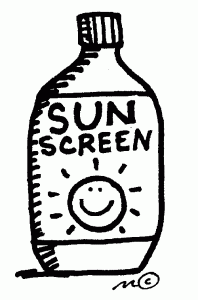While our family is spending a week at the beach – as I’m sure many others are this summer, too – I thought it would be appropriate to share my pre-vacation research on sunscreen.
There are all sorts of sunscreens on the market these days, with SPFs ranging from 15 to 50+. There are chemical sunscreens, which soak into the skin and absorb UV light, and mineral sunscreens that sit on top of the skin and block UV light.
With all of the  options out there, I wanted to know what’s the best way to avoid and sunburn and help prevent skin cancer?
options out there, I wanted to know what’s the best way to avoid and sunburn and help prevent skin cancer?
After sifting through dozens of fact sheets and studies, I found a good summary of the evidence at the Environmental Working Group’s web site. The group weighs the pros and cons of using sunblock and explains how various ingredients work.
Among the highlights, I learned that most people don’t apply enough sunscreen to achieve the maximum amount of sun protection. In fact, the best time to apply it is 15-30 minutes before heading outside.
Both chemical and mineral sunscreens work well. The important factor to look for is a “broad spectrum” sunscreen, which blocks both UVA and UVB rays.
If you’re interested in looking up a specific product, the Environmental Working Group has a database of sunscreens that evaluates the ingredients in more than 1,700 sunscreens. The group suggests avoiding ingredients with unknown side effects.
Whew! Now that I’ve got that figured out, we’re off to the beach.



Speak Your Mind